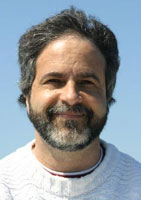 |

For further information, contact the MBL Communications Office at (508) 289-7423 or e-mail us at comm@mbl.edu
EMBARGOED UNTIL: 5:00 PM, May 5, 2008
Contact: Diana Kenney, (508)289-7139, e-mail: dkenney@mbl.edu
Back to Resource Page

Mark Alliegro
|
 |
|
|
The Cooperative View: MBL Scientists Give Evidence That Centrosomes Evolved Through Symbiogenesis
MBL, WOODS HOLE, MA—There are two ways in which cooperation is the theme of a paper published this week by Mark Alliegro and Mary Anne Alliegro, scientists at the Marine Biological Laboratory’s (MBL) Josephine Bay Paul Center.
One is revealed in the paper’s acknowledgements, where the Alliegros thank those who helped them after Hurricane Katrina completely disrupted their laboratory at Louisiana State University (LSU) in New Orleans – and their lives – in 2005.
The second is the paper’s scientific theme: the origin of the centrosome, a component of animal cells that functions in cell division. In their paper, published in Proceedings of the National Academy of Sciences, the Alliegros give evidence that the centrosome evolved through symbiogenesis – in which previously independent organisms fuse, become mutually dependent, and over time, become a single composite organism — rather than by the evolutionary process of random, heritable mutations and natural selection.
The Alliegros moved to the MBL permanently in September 2007, after two years of attempting to forge on in a devastated New Orleans. “We realized, if we stayed there, our research program would not survive,” says Mark Alliegro, who was a professor at LSU Health Sciences Center.
The origin of the centrosome, their paper points out, has been controversial for many years. The theory of symbiogenesis as a mechanism of evolution has also stirred debate since it was introduced in the 1920s and subsequently elaborated in the 1960s by Lynn Margulis of University of Massachusetts, Amherst. Today, only two cellular components – the mitochondria and the chloroplasts – are generally accepted by evolutionary biologists as having a symbiogenetic origin. The Alliegros’ paper suggests that centrosomes are another likely candidate.
They base their argument on evidence that the centrosomes, which they obtained from the eggs of the surf clam Spisula, contain RNA that is likely a remnant of a once-independent, simpler genome that was incorporated by symbiosis.
“Most animal genes have introns, regions that are transcribed into RNA but then spliced out,” says Alliegro. “But if you look at viral genes or bacterial genes, they have little or no introns. It turns out the genes for Spisula centrosomal RNAs have few or no introns. They are a special set of RNAs that derived from intron-poor or intron-less genes, which may very well support the idea that they come from a simpler organism, like a virus or bacteria.”
The Alliegros lost their RNA library due to Katrina, and in their paper they acknowledge Gloria Giarratano of LSU Health Sciences Center, who helped them re-clone the library from DNA they recovered in the hurricane’s aftermath. They also thank Bruce and Sharon Waddell of Slidell, Louisiana, in whose home they lived after Katrina, and where “our laboratory was resurrected in part from the dining room table”; as well as Carol Burdsal and other colleagues at Tulane University, where they temporarily set up a new lab. Robert Palazzo of Rensselaer Polytechnic Institute, a longtime visiting investigator at the MBL, is acknowledged for providing the centrosome preparation for the original RNA extractions as well as advice and encouragement. This work was supported by the National Institutes of Health as well as post-Katrina emergency recovery funds from the Society for Developmental Biology.
The MBL is a leading international, independent, nonprofit institution dedicated to discovery and to improving the human condition through creative research and education in the biological, biomedical and environmental sciences. Founded in 1888 as the Marine Biological Laboratory, the MBL is the oldest private marine laboratory in the Western Hemisphere. For more information, visit www.MBL.edu
Back to Resource Page
|